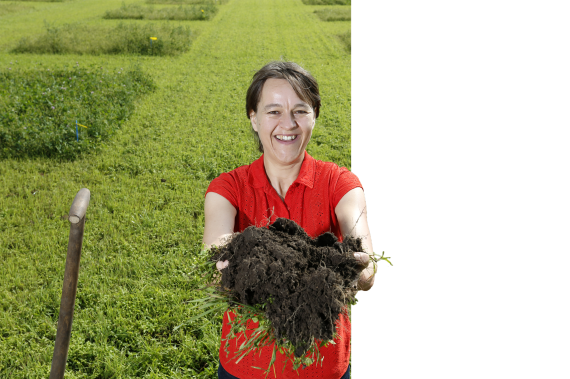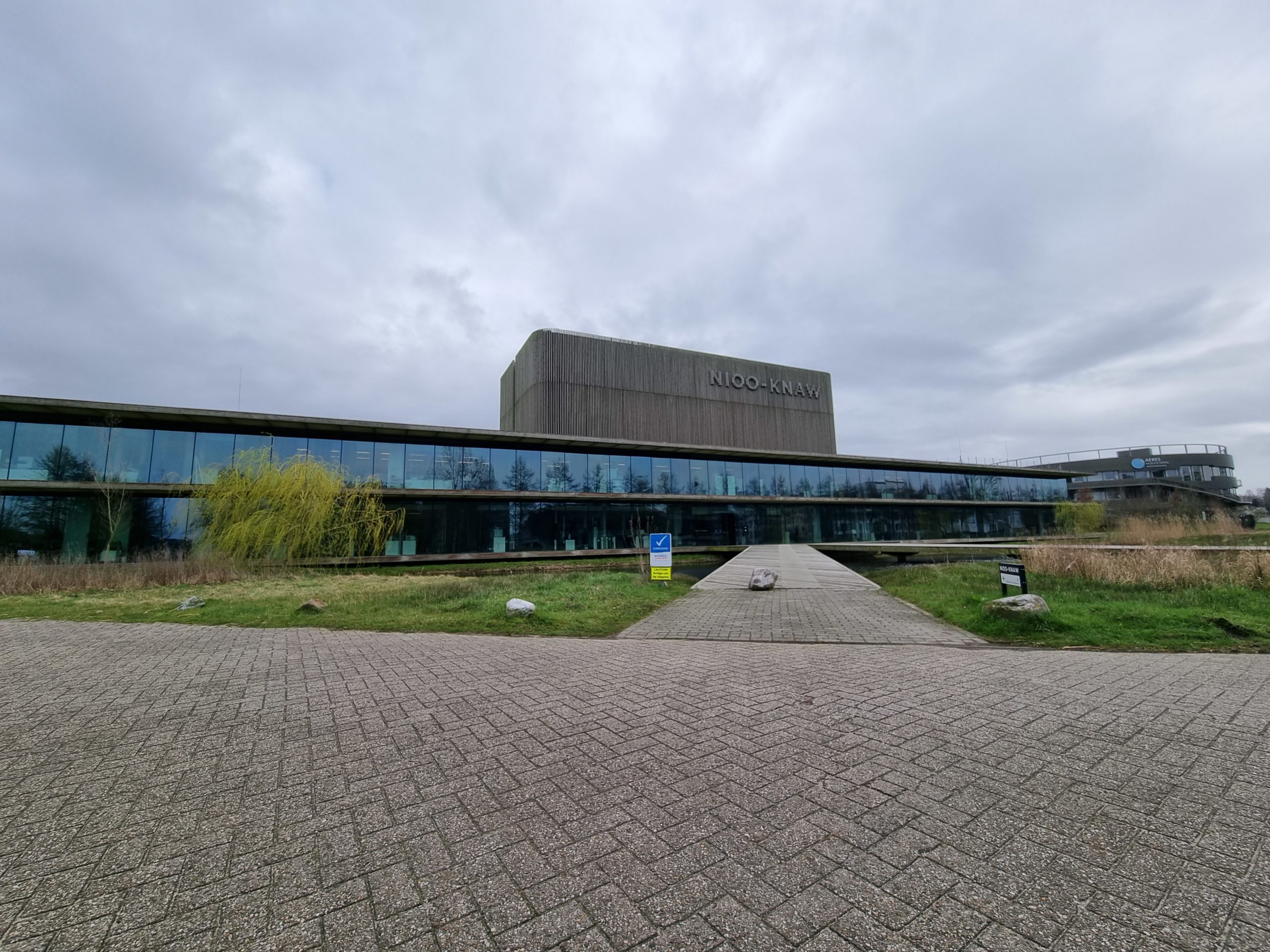Soil has got a great ambassador in Gerlinde De Deyn. Her enthusiasm never flags as she explores the wonders beneath the surface and shares her story with others. That resulted recently in her receiving the GroundBreaker Prize in America. ‘The next generation will have to rely on what we leave behind. The soil is the basis.’
Energetic is a word that springs to mind with soil ecologist Gerlinde De Deyn. Cheerful and upbeat too. She laughs a lot and often says things are ‘fantastic’ or ‘nice’. She talks rapidly with an unmistakeable Flemish accent. Imagine all that as you read this article. So, shall we begin?
Soil’s significance for the planet needs to be addressed from an early stage in our schools
In June, Gerlinde De Deyn was in New York for a chic event organized by FoodShot Global, a group of mainly American investors, to receive the very first GroundBreaker Prize. The award, worth a quarter of a million dollars, is in recognition of innovative research that brings us closer to a sustainable food chain. And that is essentially what De Deyn’s research is all about. She studies how plants and soils interact physically, chemically and biologically, and how you can use that knowledge to make both healthier. An example is growing rows of different plants in pairs next to one another so that they reinforce one another’s utilization of nutrients in the soil and become less susceptible to disease.
Unusual family
The GroundBreaker Prize is not De Deyn’s first award. ‘That was a poster prize I won in 1999 at a conference about biological pest control in Swansea. That was before I even got my PhD, at my second conference ever. I was over the moon then. I won a polo shirt that was way too big. Of course they’d been expecting some huge bloke.’ De Deyn has been awarded grants by the EU (Marie Curie), and the Dutch funding organization NWO (Talent grant, Aspasia and Vidi) and is in the running for a Vici. Then she suddenly recalls: ‘I also got a prize at kindergarten for the best drawing of a goat’. She laughs loudly at the memory.
De Deyn was born 43 years ago in Aalst in Belgium, the middle child of a family of three. She calls it ‘an unusual family’. ‘I have a sister who is 20 months older and a brother who is four years younger. My parents divorced when I was six and we all stayed with my dad. Dad taught at the secondary school that we also went to. He later got married again, this time to a man. Our mum was a teacher and we would spend every weekend or so with her. That family situation meant that I came into contact with diverse people from an early age. Nobody from university circles, though, apart from a cousin of my dad’s who worked on Alzheimer’s disease. He was at my inauguration. That was fantastic — I hadn’t seen him for 30 years.’
Great world
De Deyn decided to study bioengineering in Ghent after another relative had sparked her enthusiasm. But her love of science was only really triggered later. ‘A few weeks before I was due to graduate, a vacancy appeared for a researcher on a project about the biological control of nematodes. One of the profs asked me if I was interested. My response was OK, it sounds quite interesting and in the meantime I’ll look for a proper job. That doesn’t sound too keen, does it? I found the work fun, all that experimenting, but something was lacking. Two months later, there was a conference in Scotland. The professor wanted us researchers to go. He said, “I don’t want to see you going around together the whole time.” That remark stuck and I spent the conference accosting leading scientists in the field. I could just go up and ask them questions… and they even answered! I realized then how amazing that was. All these different people, of different ages and from different countries, could talk together about exciting topics. This is a great world!’
Culture shock
Via a Dutch friend who sent her vacancies, De Deyn got a position as a PhD candidate at the Netherlands Institute of Ecology (NIOO) in Heteren. She worked on a large biodiversity project with colleagues including Wim van der Putten, now professor of Nematology at WUR. ‘I remember the job interview at NIOO. I was a bit overdressed. It was summer and I was in a suit whereas Wim was sitting there in his shorts! We also worked together at WUR. That’s how I first got to know Wageningen.’
Her move to the Netherlands in early 2000 was something of a culture shock for De Deyn. ‘The Netherlands was much more traditional than I’d expected. That rigid attitude to time took a lot of getting used to. Freedom is very important to me. Less rigid, being open to the unexpected. I found it difficult at first. I really had to adapt. It made me realize that I’m more Belgian than I thought. In my first year, I even bought CDs of Belgian singers singing numbers in the dialect of Ghent, Antwerp or Brussels. I just had a need for that. Really weird. After getting my PhD, I spent a year working in Canada on an NWO Talent grant, followed by three and a half years at Lancaster University as a postdoc. I missed my mother tongue, though, whether the Flemish variant or Dutch.
I’m fantastically lucky to have been born with this curiosity and this fascination
One of the nice things about the Netherlands is that I speak the language, though everyone can hear I’m Belgian, of course. I find it funny that I’m that bit different. In Belgium I’m just an ordinary Belgian, right?’
Drive
Ever since De Deyn joined the WUR soil group as an assistant professor in 2011, the Flemish researcher has stood out not just for her scientific achievements but also for her many ancillary activities. She raced through the tenure track scheme, becoming a professor with a personal chair in six years, worked on the first biodiversity world atlas, is on the Gender Balance Committee and is one of the organizers of the Wageningen Science Cafe. She also made a splash with the time-lapse recordings of soil life that she produced with micro-photographer Wim van Egmond, clips from which were even used in the opening ceremony of the Olympic Games three years ago in Brazil.
Asked where she gets her drive from, De Deyn points to a Gary Larson cartoon. ‘The Far Side, with that chicken and the road — you know it? The chicken’s facing a sign saying, “THE OTHER SIDE – Why do you need a reason?” Why not cross the road? What have you got to lose? You can always learn from the experience. I like that attitude. I’m always getting all kinds of opportunities that I think sound fun. I often get asked for things — and I do say no sometimes! Of course it helps that I don’t have a family so I don’t need to be back home on time. I don’t have strictly demarcated working hours. Those extra things often start off small and you have no idea what will come of it. But I like that and I don’t see it as extra work. Perhaps I could have published more scientific papers in that time. But would that have made me happier?’
Fascination
De Deyn is also a natural optimist. ‘I think I was born that way. Whenever we went anywhere as kids, my first question would be: what can we do there?! My sister would always ask: how far is it?’ She laughs warmly. ‘I’m fantastically lucky to have been born with this curiosity and this tendency for fascination. Science wouldn’t have been my thing at all otherwise. But it’s also because of an awareness that our time on Earth is finite. When I was 16, my best friend died in a car crash. For a while, I had real problems dealing with that. But it did make me realize how pleased I am to be alive. Every day is precious and I should use my time to do things I enjoy and that are hopefully useful to the rest of the world.’
De Deyn likes to share her fascination for soil science with a broad public, and does so often. That is needed, she says. ‘Soil is cool,’ she calls out spontaneously during the photo shoot for this article while tackling the earth drill. But the general public knows next to nothing about that fantastic soil. ‘People only believe stuff when they can see it. Those time-lapse images we filmed with Wim van Egmond were to show things. People are amazed by them.
The Netherlands was more traditional than I’d expected. That rigid attitude to time took a lot of getting used to
The same amazement that I felt when I first saw root-knot nematodes through the microscope. Wow, I didn’t know that! And you don’t even need to travel far. It’s there in front of you. But if you never see it, you won’t learn to appreciate it. It’s so important to show the soil and the life in it.’
Changing mindsets
Soil biology will become mainstream if De Deyn has anything to do with it. ‘Its significance for the planet, the climate and our food needs to be addressed from an early stage in our schools. I don’t have children myself — I’ve some wonderful nephews though — but the next generation is going to have to rely on what we leave behind. The soil is the basis. If you want to change the entire food system, you have to start with the soil. If you don’t have that figured out, you’ll never achieve what you want. I hope we’ll be able to change people’s mindsets by finding out how it all works and communicating that clearly. Current farming systems have huge leaks. For example, not all the fertilizer that is spread gets used. Instead, it damages the environment because of the nitrogen compounds getting into the water and air. We are basically throwing money away. And at the expense of nature too. That can and must improve. I hope the recent IPCC report on climate change and changes in land use will wake the world up. We need our soil badly.’
Gerlinde De Deyn (1975, Aalst, België)
1993-1998 Degree in Bioengineering, Ghent University
2000-2005 PhD candidate at the Netherlands Institute of Ecology (NIOO-KNAW) and Utrecht University
2005-2006 Postdoc at the University of Guelph, Canada
2006-2009 Postdoc at Lancaster University, UK
2009-2011 Postdoc/Marie Curie fellow at NIOO-KNAW, Wageningen
2011-2016 Assistant/associate professor at Wageningen University & Research
2016-heden Professor holding a personal chair in Soil Ecology at Wageningen University & Research
Gerlinde De Deyn is deputy editor-in-chief of the scientific journal Oikos and a member of the board of the Netherlands Ecologist Research Network (NERN) and the Centre for Soil Ecology. She is single and lives in Bennekom.

 Photo: Aldo Allessie
Photo: Aldo Allessie 